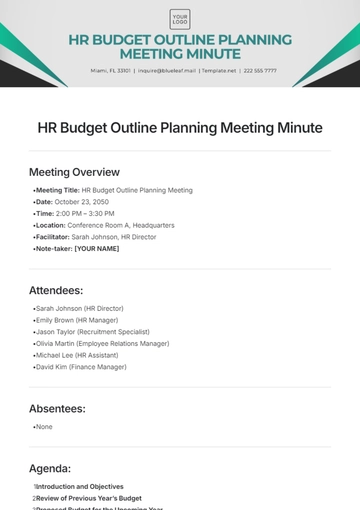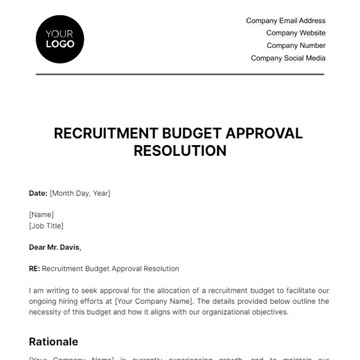Free Financial Planning and Budgeting Guide for HR Departments

TABLE OF CONTENTS
I. Introduction........................................................................................................ 4
A. Purpose of the Financial Planning and Budgeting Guide.......................................4
B. Importance of Financial Planning in HR....................................................................4
C. Scope of the Guide....................................................................................................4
II. Financial Planning Basics..................................................................................4
A. Fundamentals of Financial Planning.........................................................................4
B. Establishing Financial Goals......................................................................................4
C. Aligning HR Objectives with Financial Goals...........................................................5
D. Key Financial Metrics for HR.....................................................................................5
III. Budget Development........................................................................................5
A. Budgeting Process Overview....................................................................................5
B. HR Budget Categories...............................................................................................5
C. Cost Estimation and Allocation.................................................................................5
D. Revenue Generation...................................................................................................5
E. Capital Expenditures..................................................................................................6
IV. Expense Management......................................................................................6
A. Controlling HR Costs..................................................................................................6
B. Cost Reduction Strategies.........................................................................................6
C. Monitoring and Reporting Expenses........................................................................6
D. Contingency Planning................................................................................................6
V. Revenue Generation Strategies.........................................................................7
A. HR Revenue Sources..................................................................................................7
B. Maximizing Revenue Potential...................................................................................7
C. Investment in Revenue-Generating Initiatives.........................................................7
VI. Risk Management.............................................................................................7
A. Identifying Financial Risks.........................................................................................7
B. Mitigating Financial Risks...........................................................................................7
C. Insurance and Risk Transfer Strategies...................................................................8
VII. Reporting and Analysis...................................................................................8
A. Financial Reporting for HR.........................................................................................8
B. Performance Metrics Tracking..................................................................................8
C. Variance Analysis.......................................................................................................8
D. Adjusting Budgets as Needed..................................................................................8
VIII. Compliance and Auditing...............................................................................9
A. Legal and Regulatory Compliance............................................................................9
B. Internal Auditing Practices.........................................................................................9
C. Preparing for External Audits....................................................................................9
IX. Communication and Stakeholder Engagement...............................................9
A. Communicating Financial Plans to HR Teams..........................................................9
B. Engaging Stakeholders..............................................................................................9
C. Transparency in Financial Reporting.......................................................................10
X. Conclusion.......................................................................................................10
A. Review and Continuous Improvement....................................................................10
B. Acknowledgment of Contributors...........................................................................10
C. Document Revision History......................................................................................10
I. Introduction
A. Purpose of the Financial Planning and Budgeting Guide
The Financial Planning and Budgeting Guide for HR Departments is a cornerstone resource crafted to empower HR professionals in constructing robust financial plans and budgets customized to the unique demands of the HR department. This guide acts as an insightful compass, meticulously outlining the essential steps, strategies, and best practices necessary to ensure that HR financial planning is in harmonious alignment with the overarching fiscal health and objectives of [Company Name].
B. Importance of Financial Planning in HR
Effective financial planning is integral to the success of any HR department. It enables HR professionals to allocate resources efficiently, make informed decisions, and demonstrate the financial impact of HR initiatives on the organization. Financial planning helps us not only manage costs but also optimize HR investments to attract, retain, and develop talent.
C. Scope of the Guide
This guide provides a comprehensive framework for financial planning and budgeting within HR departments. It covers various aspects, including budget development, expense management, revenue generation strategies (if applicable), risk management, reporting, compliance, and stakeholder engagement. Whether you are a seasoned HR professional or new to financial planning, this guide will help you navigate the complexities of HR finance.
II. Financial Planning Basics
A. Fundamentals of Financial Planning
Financial planning involves the strategic allocation of resources to achieve specific goals. It requires a deep understanding of the financial landscape within which the HR department operates.
B. Establishing Financial Goals
Setting clear and measurable financial goals is the foundation of effective financial planning. Goals may include cost containment, enhancing employee benefits, or investing in HR technology.
C. Aligning HR Objectives with Financial Goals
Financial planning should closely align with HR objectives. Each financial decision should support HR initiatives that contribute to the organization's overall success.
D. Key Financial Metrics for HR
Measuring HR's financial performance requires tracking key metrics such as cost per hire, turnover rates, return on investment (ROI) for training programs, and compensation expense ratios.
III. Budget Development
A. Budgeting Process Overview
● The budgeting process typically involves several stages, including data collection, forecasting, cost estimation, and budget allocation.
● Establish a clear timeline for budget development and approval, ensuring alignment with the organization's fiscal calendar.
B. HR Budget Categories
● Identify and categorize HR expenses, such as personnel costs, recruitment and training expenses, benefits administration, technology investments, and overhead.
● Clearly define each category to facilitate accurate allocation and tracking.
C. Cost Estimation and Allocation
● Determine the estimated costs for each budget category, considering historical data, inflation rates, and anticipated changes.
● Allocate resources based on strategic priorities and the organization's financial capacity.
D. Revenue Generation
● If your HR department generates revenue (e.g., through training programs or consultancy services), outline revenue sources, pricing strategies, and revenue projections.
● Ensure revenue-generating activities align with HR objectives and comply with financial regulations.
E. Capital Expenditures
● Identify any capital expenditures required for HR initiatives, such as software or equipment purchases.
● Develop a plan for capital investments, considering their impact on long-term financial health.
IV. Expense Management
A. Controlling HR Costs
● Implement cost control measures to manage HR expenses effectively.
● Monitor budget vs. actual expenditures regularly to identify variances and take corrective actions.
B. Cost Reduction Strategies
● Develop strategies for cost reduction without compromising HR quality and effectiveness.
● Explore options like streamlining processes, renegotiating vendor contracts, or adopting cost-effective HR technologies.
C. Monitoring and Reporting Expenses
● Establish a system for tracking and reporting HR expenses, including the use of financial software or tools.
● Provide regular financial reports to HR leadership and stakeholders to ensure transparency.
D. Contingency Planning
● Prepare for unexpected financial challenges by creating contingency plans.
● Set aside reserves for emergencies or unforeseen expenses to safeguard the financial stability of the HR department.
V. Revenue Generation Strategies
A. HR Revenue Sources
● Clearly define revenue sources within HR, whether they come from training services, consultancy, or other revenue-generating activities.
● Ensure that revenue-generating activities align with HR's mission and capabilities.
B. Maximizing Revenue Potential
● Explore opportunities to expand and diversify revenue streams within HR.
● Consider partnerships, marketing strategies, or new service offerings to maximize revenue potential.
C. Investment in Revenue-Generating Initiatives
● Allocate resources strategically to support revenue-generating initiatives, ensuring they have the necessary infrastructure, marketing, and staffing.
VI. Risk Management
A. Identifying Financial Risks
● Identify potential financial risks specific to HR, such as budget overruns, compliance issues, or revenue shortfalls.
● Conduct a risk assessment to prioritize and address these risks.
B. Mitigating Financial Risks
● Develop risk mitigation strategies and contingency plans to minimize the impact of identified financial risks.
● Implement control mechanisms and internal policies to prevent financial risks from materializing.
C. Insurance and Risk Transfer Strategies
● Assess the need for insurance coverage to protect against financial risks.
● Evaluate options for risk transfer, such as outsourcing certain HR functions or seeking external partners.
VII. Reporting and Analysis
A. Financial Reporting for HR
● Develop a standardized format for financial reports, including income statements, balance sheets, and cash flow statements.
● Ensure that financial reports are accurate, transparent, and accessible to relevant stakeholders.
B. Performance Metrics Tracking
● Define key performance indicators (KPIs) for HR financial performance, such as budget variance, return on HR investments, and cost per employee.
● Implement systems to track and measure these KPIs regularly.
C. Variance Analysis
● Regularly conduct variance analysis to compare budgeted figures with actual financial performance.
● Investigate and explain significant variances, allowing for informed decision-making and course corrections.
D. Adjusting Budgets as Needed
● Be flexible in adjusting budgets when unforeseen circumstances arise or when changes in HR strategy are required.
● Ensure that budget adjustments are aligned with organizational goals and approved by relevant stakeholders.
VIII. Compliance and Auditing
A. Legal and Regulatory Compliance
● Stay abreast of all relevant HR-related laws and regulations that impact financial planning and reporting.
● Implement processes to ensure HR financial practices comply with legal requirements.
B. Internal Auditing Practices
● Conduct regular internal audits of HR financial practices to identify areas of improvement and maintain transparency.
● Establish an internal auditing schedule and methodology.
C. Preparing for External Audits
● Prepare HR financial records for external audits, ensuring that all required documentation is readily available.
● Collaborate with auditors to facilitate a smooth and efficient audit process.
IX. Communication and Stakeholder Engagement
A. Communicating Financial Plans to HR Teams
● Clearly communicate financial plans and budgets to HR staff to ensure alignment with departmental goals.
● Encourage feedback and engagement from HR teams to foster ownership and understanding of financial objectives.
B. Engaging Stakeholders
● Engage with key stakeholders, including senior management, finance departments, and executives, to garner support for HR financial initiatives.
● Collaborate with finance professionals to ensure that HR budgets align with organizational budgets.
C. Transparency in Financial Reporting
● Maintain transparency in financial reporting, sharing progress, and challenges with HR teams and relevant stakeholders.
● Foster a culture of financial responsibility and accountability within the HR department.
X. Conclusion
A. Review and Continuous Improvement
Regularly review and update the financial planning and budgeting process to adapt to changing HR needs and organizational goals.
Seek feedback from HR teams and stakeholders to identify areas for improvement.
B. Acknowledgment of Contributors
[Company Name] would like to express gratitude to all contributors and stakeholders involved in the development and implementation of HR financial plans and budgets. Your dedication and insights are essential to our financial success.
C. Document Revision History
Maintain a record of document revisions to track changes, updates, and improvements made to this Financial Planning and Budgeting Guide over time.
- 100% Customizable, free editor
- Access 1 Million+ Templates, photo’s & graphics
- Download or share as a template
- Click and replace photos, graphics, text, backgrounds
- Resize, crop, AI write & more
- Access advanced editor
Optimize HR department finances with our Financial Planning and Budgeting Guide HR Template. This comprehensive resource empowers HR professionals to create effective budgets, allocate resources efficiently, and track expenses accurately. Streamline financial processes and ensure HR initiatives align with organizational goals. Elevate your financial planning with this essential guide for HR departments.
You may also like
- Budget Sheet
- Personal Budget
- Non Profit Budget
- Monthly Budget
- Project Budget
- HR Budget
- Company Budget
- Home Budget
- Weekly Budget
- College Budget
- Business Budget
- Construction Budget
- Small Business Budget
- Hotel Budget
- Annual Budget
- Home Renovation Budget
- Household Budget
- Student Budget
- Grocery Budget
- Marketing Budget
- Corporate Budget
- Startup Budget
- Manufacturing Budget
- Church Budget
- University Budget
- Annual Budget Plan
- Event Budget
- Operating Budget
- Travel Budget
- Food Budget
- IT and Software Budget
- School Budget
- Real Estate Budget
- Sales Budget
- Conference Budget
- Budget Finance
- Freelancer Budget
- Budget Advertising











